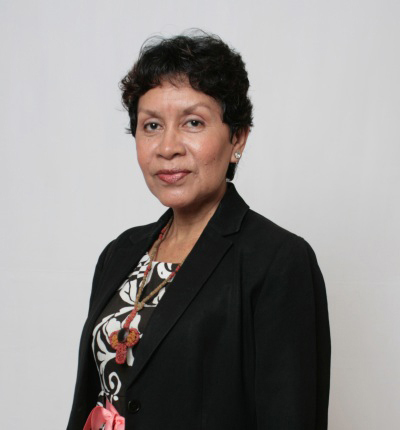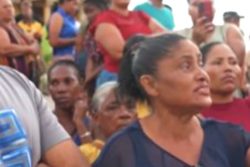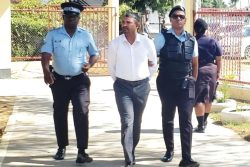Government will support a ban on rum in the Carib community of Baramita, in Region One, if requested, according to high ranking officials of the Ministry of Indigenous Peoples’ Affairs (MoIPA), who say that interventions to address some of the social ills plaguing the community have yielded some success, such as fewer reports of rape.
“With immediate interventions you wouldn’t see an immediate turnaround. It is a long road and we are in for the long haul,” Minister within the Ministry of Indigenous Peoples’ Affairs Valerie Garrido-Lowe told Sunday Stabroek.
Toshao Sharmain Rambajue recently lamented that visits by high-ranking government officials to the community have largely failed to result in tangible action to address the community’s problems, which include widespread alcohol abuse, sexual abuse and a high rate of suicide.
Recently, at a village meeting, residents suggested a ban on the selling of rum in the community. Before a decision is taken on this suggestion, Rambajue said, the village council will have to meet with the different satellite communities.
Banning the sale of rum in the village, Minister of Indigenous Peoples’ Affairs Sydney Allicock says, will have to be the village’s decision. If such a decision is taken, it will have to be gazetted as a by-law for enforcement.
Allicock, Garrido-Lowe and Permanent Secretary Alfred King spoke with Sunday Stabroek on Friday on the situation in Baramita and how government has been addressing some of the issues facing the community.
Garrido-Lowe said Baramita does not have a drinking problem. “The problem is alcoholism among men and women. It has become a way of life,” she noted, while observing that this has fueled other social ills, such as sexual abuse and incest.
“They drink themselves into a stupor, then father lying with daughter, brother lying with sister and right there for everybody to see,” she added, having pointed out that sexual exploitation of the people is not only being committed by non-residents. “It is happening among the people themselves,” she said.
Garrido-Lowe recounted a meeting with the businesspeople of the community, who suggested that it is the “culture” of the villagers to drink themselves into a stupor to commit incest. She said she told them, “How could you call alcoholism their culture when you brought in all the alcohol and keep selling it and getting them addicted? And you calling it culture?”
‘No order’
On taking office at MoIPA in 2015, Allicock explained, the issues which were festering in Baramita for decades were brought to their attention in reports prepared by the Indigenous Peoples Commission, the Amerindian Peoples Association and Guyana Human Rights Association.
“We paid a visit and found a very challenging situation that needed attention. There was no order. While Baramita sits on gold – a place there is called Golden City – you do not see the returns. We took our observations and recommendations to Cabinet and the Inter Ministerial Task Force was set up in late 2015,” he said.
He noted that the task force’s first visit found many rum shops operating illegally; the absence of teachers, and the primary school being too small for the school population, resulting in many children not going to school; police officers who had become permanent residents; and no proper infrastructure, health and other social services. He noted, too, that the village council was not accountable.
One of the first things done, Allicock said, was transferring the police officers. “When we went there first, we could not recognise who were the pork-knockers and who were the police. The police officers were wearing the big gold chains and were without shirt. They were there in the pit,” he said.
According to Garrido-Lowe, “The police officers were transferred based on allegations of sexual activities, in which they were turning a blind eye or getting involved themselves. There are now fewer reports of sexual offences.”
Previously, no female rank was posted to the community. Two women officers, including a sergeant who is now the officer-in-charge at the police station.
One of the female ranks who made school uniforms for some of the children who were not going to school, she added, is teaching a few interested people to sew.
The Guyana Geology and Mines Commission (GGMC), Allicock said, dismantled all the illegal businesses that were selling alcohol and appointed a resident Community Development Officer (CDO) to work with the village council. The ministry has also assigned a senior technical officer to support the CDO in areas of accounting, so as to strengthen governance and administration while empowering the village council. The technical officer visits the community each quarter.
“Baramita is the only village that has a CDO by itself because of its situation. A CDO is generally responsible for a cluster of villages,” Garrido-Lowe said.
To address the community’s high suicide rate, Garrido-Lowe said, the Ministry of Social Protection sent in personnel to meet with the people, but she added that not much could be done in one-off meetings. As a result, that ministry recently appointed a resident counsellor, who is a retired teacher who had worked in Baramita for over 20 years and is fluent in the Carib language.
“We cannot keep sending people from outside the village and expect to get any proper results because they cannot speak the Carib language,” she said.
In terms of education, new buildings to accommodate the primary and nursery schools, and teachers quarters, were built by the Region One administration as a result of the task force’s planning. A scholarship programme was instituted in 2016. Two students obtained places at the Government Technical Institute, one at the Guyana Industrial Training Centre and one at Carnegie School of Home Economics. Fifteen secondary school scholarships were awarded which facilitated two students at schools in the city and 13 at Port Kaituma Secondary.
While the hinterland scholarship programme has been in place even before Guyana gained its independence, Garrido-Lowe said, “Something like this never happened before.”
It was not easy to get the students out, she noted, because the church in the community has been dissuading parents from sending their children for fear of what awaits them in the outside world.
The Ministry of Education has also provided a 15-seater school bus to transport children who could not go to school because of the distance and the fear of being raped on their way to and from school. However, due to the state of the main road, the bus can only go as far as the road allows.
Another intervention, Garrido-Lowe said, was the allocation of $10 million to upgrade Aranka Road.
Allicock said, “When we first went in 2015, even the ATVs were getting stuck on Aranka Road. The focus is on making the road and trails passable in the community, while the Ministry of Infrastructure is focusing on main roads.”
Noting that the road is being rebuilt from Port Kaituma through Arakaka to Matthews Ridge and to Baramita, he said, the issue of security is again a subject of discussion. The business people in the past supported the village with a checkpoint about ten miles before reaching the village but there is need for police presence. In its village improvement plan, he said, is a plan to form a community policing group, which is supposed to take over the management of the checkpoint.
In the mines
Through the Hinterland Employment and Youth Service, Garrido-Lowe said, funding has been allocated since 2016 for a total of 26 youths of the community because of their situation. Apart from the $30,000 a month stipend, they were also given a $50,000 small business start-up grant.
“I know of four small businesses. Two young women have started small farms, another is rearing ducks and the fourth has a grocery,” she added.
The absence of an agricultural base, Garrido-Lowe said, was noted by the community and the Ministry of Agriculture came on board through the National Agricultural Research and Extension Institute (NAREI) and the Guyana Livestock Development Authority (GLDA) to promote agriculture as an economic activity and for food security.
After NAREI gave the people seeds to plant and they did not, she said, 10 households were chosen and provided with land to cultivate fruits and vegetables as a pilot. NAREI appointed a resident agricultural extension officer to oversee the project.
In terms of livestock, she said, the GLDA has committed to work with ten households as well in the rearing of the black giant chicken.
“When we first went into the community, only one or two families were farming. The rest of them were in the mines. They carry their children into the mines. I never see women look so hungry and wild. There was a child, a guy told us. She is 12-years-old and she living with she man over there,” Garrido-Lowe said.
Allicock said he saw about five women. “I don’t know if they were old or young, with batels, going in the mines where the waste is. In the afternoon, they go to the businessman, weigh off their gold, take ration that included high wine. That ration would last for the week, and then they could go back to the pit the next week, and they are living in tarpaulins with their families.”
The ministry suggested to the people, he said, to join the mining syndicate with their own gold mining operations.
“That could help in their economy. Instead of renting it out to outsiders, they could take it into their hands. That is what we were selling to them—that the GGMC could help them to develop their project until they could manage it themselves,” he said.
On people living in tarpaulins, he said, many logs, felled by miners are in the community are left to rot. “Here are people living in tents, in a gold-rich area and you have lumber lying there with which people could build proper structure. That is not being done because planning is not there. The management of the village is not there. These are areas that we have been discussing with them,” he said, while suggesting that a saw mill or board mill could be set up to cut the logs and give them to the people for housing.
Since 2015, Garrido-Lowe said, 20 families have been added to the public assistance programme due to the efforts of the Social Protection Ministry.
A new building to house the health centre has also been built and is solar powered but it is yet to be fully equipped and furnished. The Ministry of Public Health has assigned two doctors to the health centre and has sent in an ATV so that the staff could do outreaches.
A sum of $1 million was also spent for the upgrading of a playground, which had not been in use for many years.
Meanwhile, the Ministry of Citizenship, she said, has completed the registration of births of 800 residents who were without birth certificates and half of them have received their birth certificates. Without the birth certificates, children could not write exams.










